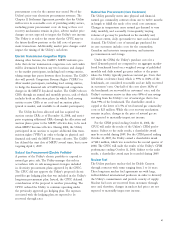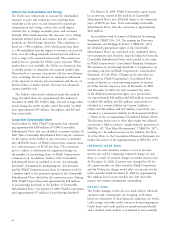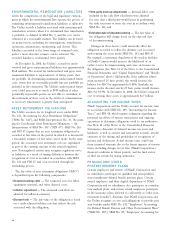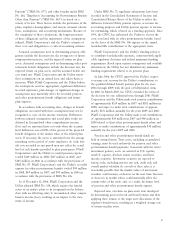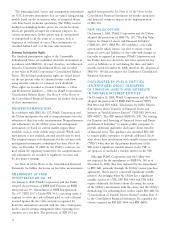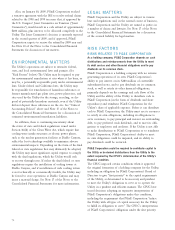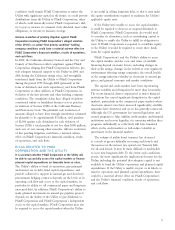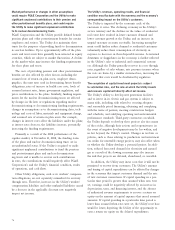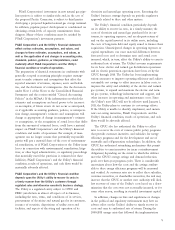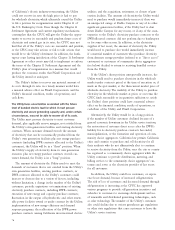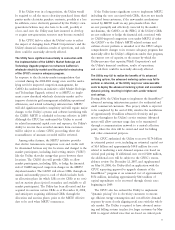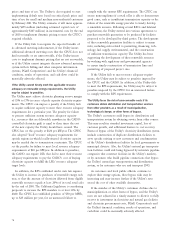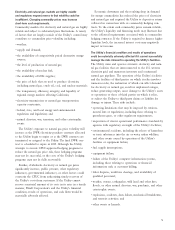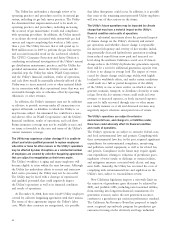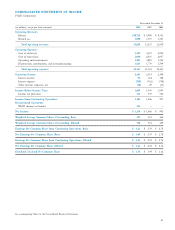PG&E 2008 Annual Report Download - page 75
Download and view the complete annual report
Please find page 75 of the 2008 PG&E annual report below. You can navigate through the pages in the report by either clicking on the pages listed below, or by using the keyword search tool below to find specific information within the annual report.73
is successful in selling long-term debt, so that it may make
the equity contributions required to maintain the Utility’s
applicable equity ratio.
If the Utility were unable to access the capital markets,
it could be required to decrease or suspend dividends to
PG&E Corporation. PG&E Corporation also would need
to consider its alternatives, such as contributing capital to
the Utility, to enable the Utility to fulfi ll its obligation to
serve. If PG&E Corporation is required to contribute equity
to the Utility, it would be required to secure these funds
from the capital markets.
PG&E Corporation’s and the Utility’s ability to access
the capital markets and the costs and terms of available
fi nancing depend on many factors, including changes in
their credit ratings, changes in the federal or state regulatory
environment affecting energy companies, the overall health
of the energy industry, volatility in electricity or natural gas
prices, and general economic and market conditions.
The capital and credit markets have been experiencing
extreme volatility and disruption for more than 12 months.
The recent fi nancial distress experienced at major fi nancial
institutions has caused signifi cant disruption in the capital
markets, particularly in the commercial paper markets where
short-term interest rates have increased signifi cantly, available
maturities have shortened, and access has generally contracted.
Although the U.S. government has enacted legislation and
created programs to help stabilize credit markets and fi nancial
institutions and restore liquidity, it is uncertain whether these
programs individually or collectively will have benefi cial
effects in the credit markets or will reduce volatility or
uncertainty in the fi nancial markets.
The volume of utility bond issuances has decreased
as a result of greater diffi culty in issuing such bonds and
the increase in the interest rate spread over Treasury bills
for all such bonds. It may be more diffi cult or undesirable
to issue new long-term debt. To the extent such conditions
persist, the more signifi cant the implications become for the
Utility, including the potential that adequate capital is not
available to fund the Utility’s operations and planned capital
expenditures. If the Utility is unable, in part or in whole, to
fund its operations and planned capital expenditures, there
could be a material adverse effect on PG&E Corporation’s
and the Utility’s fi nancial condition, results of operations,
and cash fl ows.
condition could require PG&E Corporation to infuse the
Utility with signifi cant capital in the future, or could prevent
distributions from the Utility to PG&E Corporation, either
of which could materially restrict PG&E Corporation’s abil-
ity to pay or increase its common stock dividend, meet other
obligations, or execute its business strategy.
Adverse resolution of pending litigation against PG&E
Corporation involving PG&E Corporation’s alleged violation
of the CPUC’s so-called “fi rst priority condition” holding
company conditions could have a material adverse effect on
PG&E Corporation’s fi nancial condition, results of operations,
and cash fl ows.
In 2002, the California Attorney General and the City and
County of San Francisco fi led complaints against PG&E
Corporation alleging that PG&E Corporation failed to pro-
vide adequate fi nancial support to the Utility in 2000 and
2001 during the California energy crisis, and wrongfully
transferred funds from the Utility to PG&E Corporation
during the period 1997 through 2000 (primarily in the
form of dividends and stock repurchases), and from PG&E
Corporation to other affi liates of PG&E Corporation, in
violation of the fi rst priority and other holding company
conditions. The complaints claim these alleged violations
constituted unfair or fraudulent business acts or practices
in violation of Section 17200 of the California Business
and Professions Code. The plaintiffs seek restitution of
amounts alleged to have been wrongly transferred, estimated
by plaintiffs to be approximately $5 billion, civil penalties
of $2,500 against each defendant for each violation of
Section 17200, a total penalty of not less than $500 million,
and costs of suit, among other remedies. Adverse resolution
of this pending litigation could have a material adverse
effect on PG&E Corporation’s fi nancial condition, results
of operations, and cash fl ows.
RISKS RELATED TO PG&E
CORPORATION AND THE UTILITY
It is uncertain whether PG&E Corporation or the Utility will
be able to successfully access the capital markets or fi nance
planned capital expenditures on favorable terms or rates.
The Utility’s ability to fund its operations, pay principal
and interest on its debt, fund capital expenditures, and
provide collateral to support its natural gas and electricity
procurement hedging contracts depends on the levels of its
operating cash fl ow and access to the capital markets, in
particular its ability to sell commercial paper and long-term
unsecured debt. In addition, PG&E Corporation’s ability to
make planned investments in natural gas pipeline projects
depends on the ability of the Utility to pay dividends to
PG&E Corporation and PG&E Corporation’s independent
access to the capital markets. PG&E Corporation may also
be required to access the capital markets when the Utility


